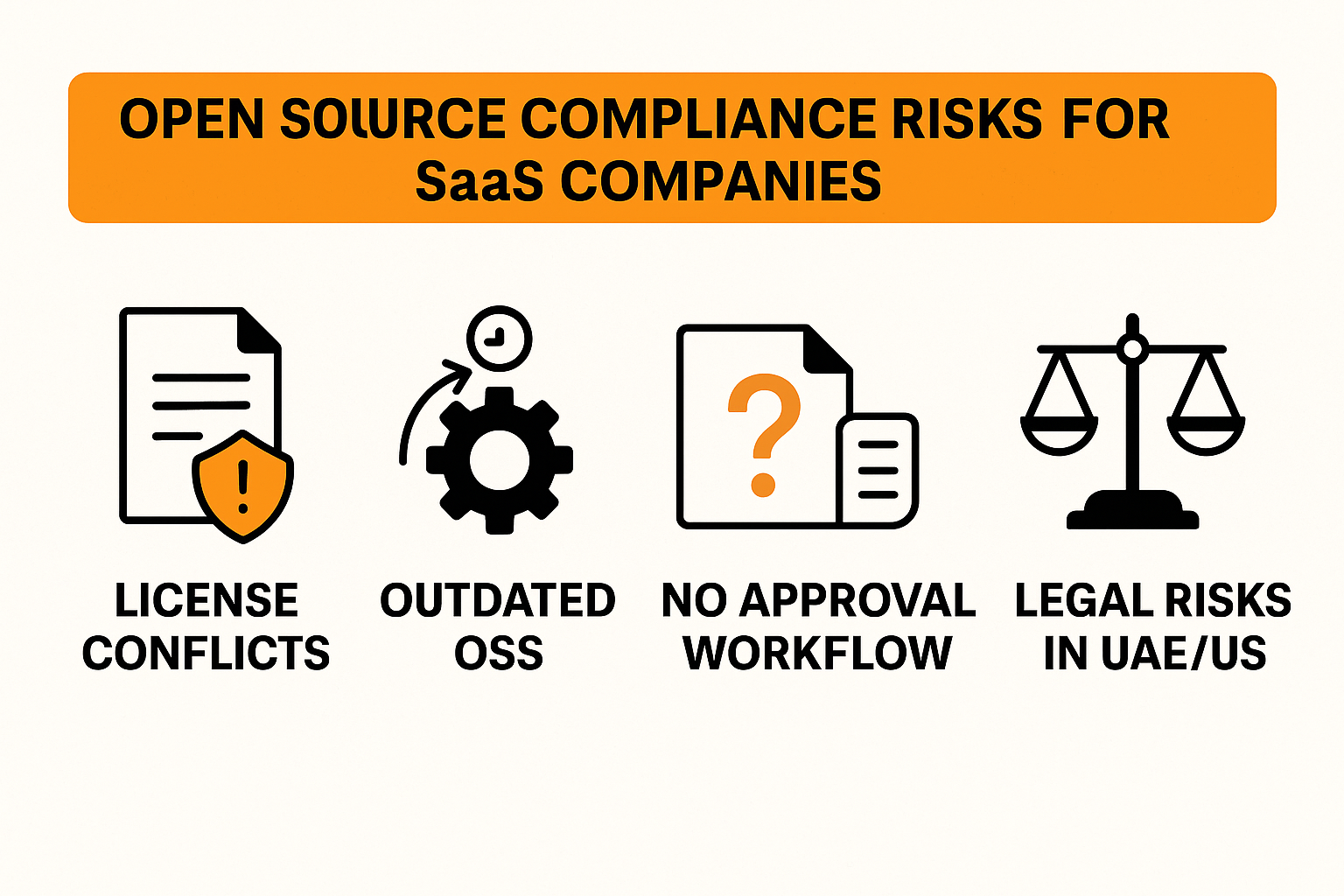Why SaaS Scaling Comes with Open Source Risk
Open source compliance for SaaS companies is no longer optional. As your platform grows, so do your dependencies — and many of them are buried in open source libraries that haven’t been reviewed for legal, security, or licensing risks.
Startups in the UAE and USA often move fast to meet investor expectations or capture market share. But that speed can turn into exposure, especially when overlooked licenses or outdated packages trigger compliance red flags.
Whether you’re raising a Series A in Dubai or prepping for acquisition in New York, open source risk is real. Regulators like the UAE’s Securities and Commodities Authority (SCA) and U.S.-based legal advisors are beginning to ask deeper questions about what’s inside your codebase — and how you’re managing it.
This blog outlines everything UAE and US founders need to know before scaling. Let’s begin with the basics: what really counts as “open source” in SaaS, and why it matters more than ever.
What Counts as “Open Source” in SaaS?
When we talk about open source in the SaaS world, most founders think of GitHub repositories or NPM packages — but it goes deeper than that. Your frontend libraries, backend frameworks, third-party SDKs, database engines, and even some container templates often include open source software (OSS) components.
The problem? Not all OSS is licensed equally. And not all licenses are safe for commercial use.
In SaaS environments, you’re not just consuming software — you’re integrating it, layering your IP on top, and distributing functionality to end users. That means certain licenses (like AGPL or LGPL) could actually bind your entire codebase to obligations you didn’t sign up for.
Founders scaling in the UAE should be particularly aware of how this ties into SCA regulations. If your product is touching financial, healthcare, or government data, or if you’re bidding for contracts where auditability is mandatory, undocumented OSS use could disqualify your solution.
Similarly, in the U.S., investors and acquirers are increasingly prioritizing OSS licensing audits during due diligence. A missing license file or incompatible dependency can delay or kill a deal.
If you’re unsure which packages you’re using or how they’re licensed, it’s time to build a formal compliance process. Start with a full OSS inventory, and refer to tools like a due diligence checklist to track and assess the risk.
Top Open Source Risks SaaS Founders Overlook
When scaling a SaaS product, founders often focus on speed and feature delivery. Compliance is usually an afterthought — until it becomes a problem.
One of the biggest risks is license conflicts. Many OSS components come with conditions that restrict how you use or distribute your code. If your platform integrates a copyleft license like GPL or AGPL, you could be forced to release your proprietary code.
Another major issue is outdated packages. These are vulnerable to known exploits and rarely get flagged unless you’re scanning them regularly. A single insecure dependency can put user data or uptime at risk.
Startups also overlook the need for an SBOM (Software Bill of Materials). Without it, you can’t show what OSS is in your stack, let alone how it’s licensed or where it came from.
In both the UAE and US, this lack of transparency raises red flags for investors, clients, and regulators. It’s not enough to say “we use open source” — you need to show that you understand and manage the risks.
If you’re unsure where to begin, explore our Open Source Compliance Management service. It’s designed to help SaaS companies get ahead of these issues before they block growth.
Why Compliance Gets Harder as You Scale
In the early days, it’s easy to keep track of what goes into your product. One dev team, one repo, one build system.
But as you scale, more developers join. More tools, microservices, and dependencies are added. Suddenly, no one knows what’s in the stack — or who approved it.
Your CI/CD pipeline might be pulling in packages automatically. That’s great for speed, but dangerous without review. Compliance gets buried beneath feature updates.
Scaling across regions adds another layer. SaaS platforms operating in both the UAE and the US must deal with local software laws, data handling regulations, and compliance expectations that differ by market.
If you haven’t built an internal policy or approval workflow for OSS usage, things can get out of hand quickly. And when that happens, fixing it mid-scale is far more painful than doing it early.
For startups ready to scale, this is a crucial moment to act. Before expanding teams or entering new markets, get your open source compliance in order.
What UAE Founders Must Know About Software Regulation
In the UAE, regulatory expectations are rising fast — especially in sectors like fintech, healthtech, and govtech.
The Securities & Commodities Authority (SCA) expects companies handling sensitive data to demonstrate software transparency. That includes knowing which open source components you’re using.
If your SaaS product integrates third-party OSS without proper documentation, it may not pass vendor approvals or procurement reviews. In some cases, it could disqualify you from government-linked contracts.
Startups targeting enterprise or government clients in the UAE must treat open source compliance like a legal and reputational requirement — not just a technical task.
Build clear OSS usage policies. Maintain version histories. And be ready to show documentation when asked.
OSS Licensing in the USA: What SaaS Startups Must Understand

In the US, licensing violations are taken seriously — especially during mergers, acquisitions, or funding rounds.
Founders must know the difference between permissive licenses (like MIT or Apache 2.0) and restrictive ones (like GPL or AGPL).
SaaS companies often assume that “we’re not distributing software” so licenses don’t apply. That’s a mistake. Under some licenses, remote access to your platform still counts as distribution.
If you’re using AGPL code in your backend and haven’t disclosed it, you might be required to open source your entire application. That can kill deals instantly.
Legal teams and VCs in the US will often conduct a full OSS audit before closing a round. If you can’t pass that audit, it can delay funding or even lead to legal consequences.
Don’t wait until due diligence. Build a process now.
This OSS compliance audit guide explains what to expect — and how to prepare for it.
Corrected Section 6: Common Compliance Mistakes SaaS Companies Make
Most SaaS teams don’t ignore compliance. They just assume someone else is responsible for it.
Here are some of the most common mistakes:
- Using OSS packages without checking licenses
- Copying code from public repositories into production
- Failing to track modified or forked components
- Skipping documentation for internal or client reviews
- Not training developers on OSS usage policies
These gaps might seem small but they can lead to serious legal and financial risks.
One of the most dangerous assumptions is treating open source software like it’s free to use without conditions. In reality, many licenses come with obligations — whether you’ve read them or not.
If your team doesn’t have a shared understanding of what’s allowed, the risk compounds quickly.
Read our guide to common open source compliance mistakes to stay ahead of trouble.
How to Build a SaaS-Focused Open Source Compliance Program
Start with visibility. You can’t manage what you don’t track.
Create a full Software Bill of Materials (SBOM) for your product. This is a list of every OSS component you use, along with its license and version.
Use tools that scan your repositories for license types and known vulnerabilities. Most of these tools can be connected to your CI/CD pipeline.
Set up an internal OSS approval workflow. Before adding new libraries, developers should submit them for review.
Write down your policy. It doesn’t have to be long. Just keep it clear and easy to follow. Include rules for usage, contributions, forking, and disclosures.
Train your team. Compliance is not just about legal protection. It’s about building a culture where developers understand the impact of every open source decision.
If you’re not sure where to begin, our Open Source Compliance Management service is designed to help SaaS companies like yours stay compliant and scalable.
Checklist: What Every SaaS Company Should Have Before Scaling
Before you move into new markets or raise your next round, your SaaS company should have these compliance basics in place:
- A complete Software Bill of Materials (SBOM)
- An internal policy for OSS usage
- A developer onboarding process that covers open source rules
- Approval workflows for new libraries
- A central record of license types, versions, and origins
- A compliance point of contact for legal or investor discussions
- An audit-ready report you can share during due diligence
If any of these are missing, now is the time to close those gaps. These aren’t just technical tasks — they are growth enablers.
Compliance is Not a Roadblock. It’s a Growth Signal.
Investors, clients, and regulators now expect SaaS companies to treat compliance seriously. Having a clear open source policy shows that you’re ready to scale responsibly.
If you build compliance into your product early, you’ll avoid delays, reduce risk, and gain trust with stakeholders.
Don’t wait until due diligence reveals problems. Proactive action now will save you time, money, and credibility later.
Ready to Take Control of Your OSS Risk?
If you’re growing a SaaS company in the UAE or the US, open source compliance isn’t optional anymore.
We help startups design clear, scalable, and audit-ready compliance programs tailored to their tech stack and growth goals.
Talk to our team and let’s get your foundation in place before the next big milestone.



